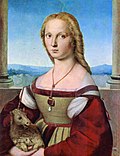Mona Lisa
The Mona Lisa (also known as La Gioconda or La Joconde) is a 16th-century portrait, painted in oil by Leonardo da Vinci during the Renaissance in Florence, Italy. Many people think Mona Lisa's smile is mysterious.[1] Mona Lisa also has no eyebrows, it is believed that this was because they were accidentally removed during a restoration.[2][3] Because it is so often studied, recognized, and copied, it is considered to be the most famous painting in the world.[4][5][6] The Louvre says that about 80 percent of its visitors come to see the painting of Mona Lisa.[6] According to art experts, the Mona Lisa is the best known, most visited, and overall most famous work of art in the entire world.
| Italian: La Gioconda, French: La Joconde | |
| Mona_Lisa,_by_Leonardo_da_Vinci,_from_C2RMF_retouched.jpg | |
| Artist | Leonardo da Vinci |
|---|---|
| Year | c. 1503–1519 |
| Type | Oil on poplar |
| Dimensions | 76 cm × 53 cm (30 in × 21 in) |
| Location | Musée du Louvre, Paris |
Acquired by King Francis I of France, the Mona Lisa is now the property of France. It is on permanent display in Paris at the Louvre museum. Millions of visitors come to Paris every year to see the enigmatic smile on Mona Lisa's lips.[7] Giorgio Vasari, who was Leonardo's first biographer (a person who writes about the life of another person), thought the painting was of a person named Lisa Gherardini. Speculation over the painting's model was solved in 2008 by Dr Armin Schlechter, a manuscript expert. Notes discovered in Heidelberg University Library which were written by Agostino Vespucci, a Florentine city official, reinforced Vasari's earlier identification of the model. Lisa was the wife of Francesco del Giocondo a rich silk merchant, who lived in Florence.
Although the sitter has traditionally been identified as Lisa del Giocondo, a lack of definitive evidence has long fueled alternative theories, including Leonardo's mother Caterina in a distant memory and glorified as the Virgin Mary as the painting’s subject. According to this theory, at the time that Leonardo painted the portrait of his mother, whom he adored, she was not among the living. She died in 1495. The idea is that she was alive in Leonardo's imagination. Lisa del Giocondo's job was to be the model only.[8]
Leonardo began painting the Mona Lisa in 1503 or 1504 in Florence, Italy.[9] According to Da Vinci's contemporary, Giorgio Vasari, "...after he had lingered over it four years, left it unfinished....". The painting was brought to France by Leonardo in 1516 and it was bought by Francis I of France.
The Mona Lisa used to hang in the Chateau Fontainebleau and was then moved to the Palace of Versailles. After the French Revolution, Napoleon I of France had it hanging in his bedroom in the Tuileries Palace, but it was later moved to the Louvre where it is still hanging today.
Stolen
On August 21, 1911, the Mona Lisa was stolen. The Louvre museum thought it was being photographed, but when they checked, it was not there. The Louvre closed for one week to help look for it.
People thought Guillaume Apollinaire, a French poet, stole it. He was put into jail, and tried to make people think his friend Pablo Picasso did it, and he was questioned. It was not either of them, though.
It was lost for two years, and everybody thought it would be lost forever. A worker at the Louvre, named Vincenzo Peruggia, had actually stolen it. He had hidden it in his coat and walked out with it after the museum had closed. He wanted the painting to go back to Italy and be shown in an Italian museum. After hiding it in his apartment for two years, he grew impatient and tried to sell it to a gallery in Florence, but was caught. It was shown all over Italy before going back to the Louvre. People thought Vincenzo was a hero who loved Italy, so he only spent a few months in jail.
Other articles
Mona Lisa Media
A margin note by Agostino Vespucci (visible at right) discovered in a book at Heidelberg University. Dated 1503, it states that Leonardo was working on a portrait of Lisa del Giocondo.
(Left to right) US President John F. Kennedy, Madeleine Malraux, André Malraux, Jacqueline Kennedy, and Lyndon B. Johnson at the unveiling of the Mona Lisa at the National Gallery of Art during its visit to Washington, D.C., 8 January 1963
Young Woman with Unicorn by Raphael, c. 1506
References
- ↑ "Noisy secret of Mona Lisa's smile - 23 June 2004 - New Scientist". newscientist.com. Retrieved 4 January 2011.
- ↑ "Mona Lisa Once Had Eyebrows, Says Expert - CBS News". www.cbsnews.com. 2007-10-22. Retrieved 2024-08-25.
- ↑ Charney, Noah (2024-02-06). The Thefts of the Mona Lisa: The Complete Story of the World's Most Famous Artwork. Rowman & Littlefield. ISBN 978-1-5381-8137-9.
- ↑ Henry Thomas and Dana Lee Thomas, Living biographies of great painters, Garden City Books, 1959, p.50.
- ↑ Charles Donald O'Malley, Leonardo's legacy: an international symposium, University of California Press, 1969, p.121.
- ↑ 6.0 6.1 Riding, Alan (6 April 2005). "The New York Times > Arts > Art & Design > In Louvre, New Room With View of 'Mona Lisa'". The New York Times. https://www.nytimes.com/2005/04/06/arts/design/06lisa.html?_r=1. Retrieved 4 January 2011.
- ↑ Studio's, Paintings. "Mona Lisa is arguably the most recognizable image in Western art". Retrieved 2021-11-19.
- ↑ Roni Kempler: Who the Mona Lisa Is 2017, TXu 2-064-715, Google Site. Mona Lisa, painting by Leonardo da Vinci, View article history, Roni Kempler's contributions, Encyclopædia Britannica
- ↑ Wiesner-Hanks, Merry E. (2005). An Age of Voyages, 1350-1600. Oxford University Press, USA. p. 26. ISBN 978-0-19-517672-8.
Other websites
- Louvre Archived 2017-09-02 at the Wayback Machine Mona Lisa.







